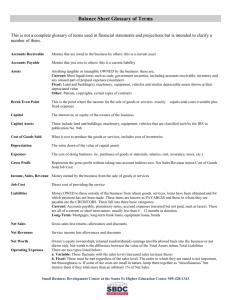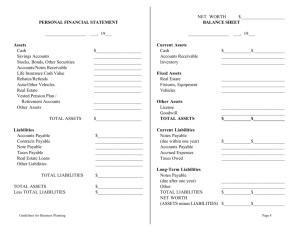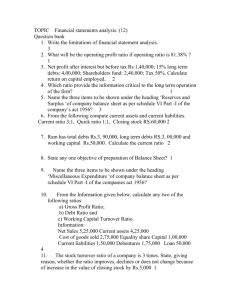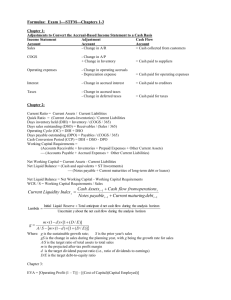1st Annual New York StartUP! Business Plan Competition
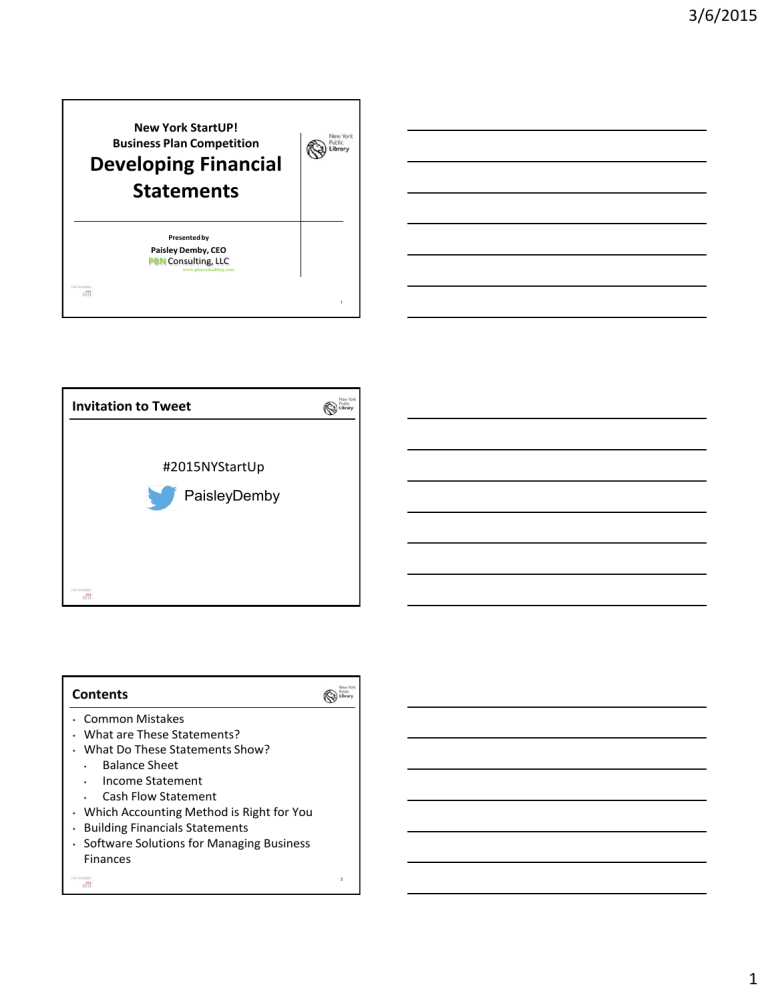
New York StartUP!
Business Plan Competition
Developing Financial
Statements
Presented by
Paisley Demby, CEO
PBN Consulting, LLC
www.pbnconsulting.com
1
Invitation to Tweet
#2015NYStartUp
PaisleyDemby
•
•
•
•
•
•
Contents
•
Common Mistakes
What are These Statements?
What Do These Statements Show?
Balance Sheet
•
•
Income Statement
Cash Flow Statement
Which Accounting Method is Right for You
Building Financials Statements
Software Solutions for Managing Business
Finances
3
3/6/2015
1
Common Mistakes
Not including all statements
Not understanding what drives revenue
Over or under-estimating cost
Underestimating time to generate revenue
Lack of comparables
No assumptions or notes to financials
4
Introduction
Every business decision leads to a number, and taken together, these numbers form the basis of your financial statements.
•
Balance Sheet
•
•
Income Statement
Cash Flow Statement
5
Financial Statement Overview
Balance Sheet
What a company owns, what it owes, and what is left over
Income Statement
A firm’s sales, expenses, and profit (or loss)
Cash Flow Statement
The sources, uses, and balance of cash, shown on a monthly basis
6
3/6/2015
2
Introduction
One statement is not enough
Each provides a slightly different view
•
Put several statements together and you can make smart :
Financial
•
•
Investment
Management decisions
7
Introduction
Your financials are merely the natural result of decisions you make in your business.
8
Balance Sheet
What Does A Balance Sheet Tell You?
A financial statement that summarizes a company's
Assets
Liabilities owns owes
Shareholders‘ Equity the difference
The Balance Sheet is a picture of your business, frozen for a second in time.
9
3/6/2015
3
Balance Sheet
Assets – Liabilities = Capital (Owners Equity)
A company's assets have to equal, or "balance," the sum of its liabilities and shareholders' equity.
A company has to pay for all the things it has
( assets ) by either borrowing money ( liabilities ) or getting it from shareholders ( shareholders' equity ).
Assets
Liabilities +
Owners Equity
10
Balance Sheet
Assets
Economic resources owned by a business or company.
Divided into two categories: current and noncurrent . They are listed according to how liquid they are (how quickly they can be turned into cash).
Examples of current assets are cash and inventory
Examples of non-current assets are furniture, fixtures, property and equipment.
11
Balance Sheet
Liabilities (Debts you owe)
Divided into two categories: current and noncurrent (or long-term). They are listed in the order they need to be repaid.
Example of liabilities are debt, accounts payable, unpaid taxes, and outstanding loans .
12
3/6/2015
4
Balance Sheet
Capital or Net Worth or Owners Equity
The business’ equity includes money the owners have invested and income kept in the business from the company’s profits.
13
Balance Sheet - What It Shows You
• Assets owned by the company
• Liabilities owed by the company
• The net value (difference) of the business
• How much of loan debt is current, and how much is long-term
14
Balance Sheet
Non Current
Assets
Assets that convert to cash in less than 1 year
Advances to Owners
Money owners take in the form of a loan
Rut Row Dog Company Balance Sheet
December 2013
ASSETS (What You Own)
Current Assets (Converts to cash in less than one year)
Cash………………………………………………………………..….10,000
Accounts Receivable……………………………………………...…65,000
Inventory…………………………………………………………....…85,000
Total Current Assets …………………………………………….. ……………..160,000
Non Current Assets (more than one year to convert to cash)
Fixed Assets (furniture, fixtures, property and equipment ……..150,000
Less Accumulated Depreciation……………………………….……35,000
Fixed Assets (net )…………………………………………………..115,000
Advances to Owners ……………………………………………..…...6,000
Total Noncurrent Assets (115K + 6K)………………………………………....121,000
Total Assets (160K + 121K)………………………………………………………281,000
Accounts
Receivable
Sales made with money still owed to the company
Fixed Assets
Recorded at original cost
Depreciation
Assets lose their value.
Deductions are made according to tax rules
TOTAL ASSETS = $281,000
15
3/6/2015
5
Balance Sheet
Current
Portion of
Long Term
Debt
1 years worth of Loan
Payments
Loan Payable
Loan balance after one years worth of loan payments.
Owners
Investment
Money
Owners invest in the business
Rut Row Dog Company Balance Sheet
December 2013
LIABILITIES (What Your Owe)
Current Liabilities (due in one year)
Accounts Payable…….…………………………………………..….41,000
Accrued Taxes……..……………………………………………...…..3,000
Current Portion of Long Term Debt…..………………………....…..6,000
Note Payable (Due within one year)…..……………………….....100,000
Total Current Liabilities ……………………………………………..
……………..150,000
Long Term Liabilities (due more than one year)
Loan Payable ………………………………………………………...44,000
Total Long Term Liabilities ……………….…………………….. ………………44,000
Total Liabilities (150K + 44K )…………………………………........………......194,000
CAPITAL OR NET WORTH (The Company’s Equity)
Owner Investment…………………………………………………….. 20,000
Retained Earnings…………………………………………………..…67,000
Total Capital or Net Worth (67K + 20K)……………………………………....... 87,000
Total Liabilities & Capital (194K + 87K)…………………….…………………. ..281,000
Accounts
Payable
Purchases not paid for
Retained
Earnings
Money left in the business from the company’s profits accumulated over the life of the business
16
Income Statement
Like of report card for your business
Issued from time to time
Gives an overview of how you are doing (for that period of time).
The Income statement reflects your business activity over time it is usually developed monthly , quarterly and annually .
17
Income Statement - What It Shows
•
•
•
•
•
•
Company’s Revenue
Sales
Company’s Expenses
Cost of products the company sold (COGS)
Selling marketing, and administrative cost
Depreciation
Interest Expense on Debts
Taxes on profits
= Net Income
18
3/6/2015
6
•
•
•
•
•
Income Statement - What It Shows
Are sales going up or down
Increases or decreases in cost
What it costs to produce or purchase the product
All expenses for the time period it covers
Increases and decreases in profit
19
I ncome Statement
Gross Sales
Revenue or income before returns and allowances
Selling
Expense
Salaries and
Expenses related to sales only
Revenue
Less Cost of Goods Sold (Cost To Make Products)
Gross Profit
Operating Expense:
Selling Expenses
General and Administrative
$ 100,000
Operating
Income shows how good the business performed
Total Expenses
Operating Income
Less Interest Expense (on Loans)
Net Profit Before Taxes (255K - 20K)
Less All Income Taxes
Net Profit (235K - 82.5K)
$ 1,000,000
$ 600,000
$ 400,000
$ 145,000
$ 255,000
$ 20,000
$ 235,000
$ 82,250
$ 152,750
100%
60%
40%
Gross Profit
Also your
Gross
Margin
15%
26%
2%
24%
8%
10%
5%
General
Admin
All other expenses used to run the business
15%
Net Profit
Profit Left after all expenses have been paid
20
Income Statement
•
•
•
•
Other Names
Operating Statement
Earnings Statement
Profit & Loss Statement (P&L)
Statement of Income
21
3/6/2015
7
The Cash Flow Statement
What Does A Cash Flow Statement Tell You?
The Cash Flow Statement shows money that comes into the business, money that goes out and money that is kept on hand to meet daily expenses and emergencies.
Keep in mind that companies can produce a profit, but still not have a positive cash flow
22
The Cash Flow Statement
What It Shows You
If the business has enough money to:
cover day-to-day activities pay debts on time maintain and grow the business without a negative cash flow
23
Rut Row Cash Flow Statement
December 2010
The Cash Flow Statement March
$ 13,741
B. Cash Receipts
1. Cash Sales
2. Collections for Credit Accounts
3. Loan or Other Cash Injections
C Total Cash Receipts
D. Total Cash Available
E. Cash Paid Out:
1. Purchases (Merchandise)
2. Gross Wages
3. Payroll Expenses (Taxes Etc)
4. Outside Services
5. Supplies
6. Repairs and Maintenance
7. Adverting
8. Car Delivery and Travel
9. Professional Services
.
17. Subtotal
F. Other Operating Cost
1. Loan Principal Payment
2. Capital Purchases
3. Other Startup Cost
4. Reserve and or Escrow
5. Owners Withdrawal
G. Total Cash Paid Out
H. Cash Position (D-G)
$ 32,813
$ 32,813
$ 42,813
$ 10,758
$ 1,076
$ 383
$ 758
$ 390
$ 4,200
$ 2,700
$ 1,500
$ 24,893
$ 293
$ -
$ 10,000
$ 2,000
$ 37,186
$ 5,627
$ 75,000
$ 75,000
$ 80,627
$ 10,758
$ 1,076
$ 383
$ 758
$ 390
$ 4,200
$ 2,700
$ -
$ 54,591
$ 295
$ -
$ -
$ 10,000
$ 2,000
$ 66,886
$ 13,741
$ 76,250
$ 76,250
$ 89,991
$ 11,364
$ 1,136
$ 408
$ 808
$ 416
$ 4,200
$ 2,700
$ 67,590
$ 296
$ 10,000
$ 2,000
$ 79,886
$ 10,105
April
$ 10,105
$ 81,250
$ 81,250
$ 91,355
$ 11,970
$ 1,197
$ 434
$ 422
$ 422
$ 4,200
$ 2,700
$ 1,500
$ 70,337
$ 300
$ 10,000
$ 2,000
$ 82,637
$ 8,718
24
3/6/2015
8
Accounting Methods
The Cash Method
Records a sale when money is collected
Records an expense when it is paid
25
Accounting Methods
The Accrual Method
Sales are made on credit, and not immediately
paid for. The amount customers owe is called
Accounts Receivable
Buy items or incur expenses for the business, but pay later. The amount owed is called
Accounts Payable .
Net worth does not always translate to cash, since money can be tied up in Accounts
Receivable, expenses and inventory.
Lenders prefer the accrual method
.
26
Guidelines for Preparing Financials
Things take longer and cost more than planned
27
3/6/2015
9
Guidelines for Preparing Financials
1.
2.
3.
4.
Start with the Income Statement
Identify all of your revenue sources
Determine your revenues for a typical day
Understand your revenue drivers
How many customers you will serve
5.
How many products they will buy
How much they will pay for each product/service
Understand and identify your cost
28
Guidelines for Preparing Financials
1.
Calculate average daily revenue
Revenue Worksheet
Product/Service
Description
1. Dog Clothing
2. Dog Boots
3. Leashes
4. Toiletries
5. Dog Food
Price
$ 50.00
$ 10.00
$ 10.00
$ 30.00
$ 15.00
Units Sold Per Day
75 visitors * 75% *1.5 Clothing Items
75 visitors * 15% *1 Dog Boot
75 visitors * 5% *1 Leash
75 visitors * 30% *1.2 Toiletries
75 visitors * 25% *1 Dog Food
Assumptions
Traffic - 75 Visitors per day
1.5 Clothing bought by 54% of visitors
1 Dog Boots by 155 of visitors
1 Leash for 5% of visitors
1.2 Toiletries by 30% of visitors
1 Dog Food bought by 25% of visitors
40% of sales will occur during Christmas
30% of sales will occur during the Summer
Total Revenue
$ 4,218.75
$ 112.50
$ 37.50
$ 1,012.50
$ 281.25
$ 5,662.50
Daily
5,662.5
* 20
$ 113,250
Monthly
29
Guidelines for Preparing Financials
2.
Determine cost of good sold (COGS)
Cost of Goods Sold Worksheet
Product/Service
Description
1. Dog Clothing
2. Dog Boots
3. Leashes
4. Toiletries
5. Dog Food
Price
$ 50.00
$ 10.00
$ 10.00
$ 30.00
$ 15.00
Gross Margin (%)
50
50
50
50
50
Revenue
$ 4,218.75
$ 112.50
$ 37.50
$ 1,012.50
$ 281.25
$ 5,662.50
COGS
$ 2,109.38
$ 56.25
$ 18.75
$ 506.25
$ 140.63
$ 2,831.25
Total Revenue
COGS
Gross Profit
Gross Profit Margin
$ 5,662.50
$ 2,831.25
$ 2,831.25
50%
30
3/6/2015
10
Guidelines for Preparing Financials
3.
Determine monthly operating cost
Operating Cost Worksheet
Expense
1. Purchases (Mechandise)
2. Gross Wages
3. Payroll Expenses (Taxes Etc)
4. Outside Services
5. Supplies
6. Repairs and Maintenance
7. Advertising
8. Car Delivery and Travel
9. Profesional Services
10. Rent
11. Telephone
12. Utilities
13. Insurance
14. Other Miscelaneous
Daily
$ 2,831
$ 750
$ 75
$ 19
$ 38
$ 20
$ 210
$ 135
$ 75
$ 300
$ 10
$ 25
$ 29
Monthly
$ 56,625
$ 15,000
$ 1,500
$ 383
$ 758
$ 390
$ 4,200
$ 2,700
$ 1,500
$ 6,000
$ 200
$ 500
$ 583
Yearly
$ 679,500
$ 180,000
$ 18,000
$ 4,596
$ 9,096
$ 4,680
$ 50,400
$ 32,400
$ 18,000
$ 72,000
$ 2,400
$ 6,000
$ 7,000
Total
$ 679,500
$ 180,000
$ 18,000
$ 4,596
$ 9,096
$ 4,680
$ 50,400
$ 32,400
$ 18,000
$ 72,000
$ 2,400
$ 6,000
$ 7,000
Total $ 4,517 $ 90,339 $ 1,084,072 $ 1,084,072
31
Guidelines for Preparing Financials
4. Compute one month of income and expenses
Income Statement - 12 Months
Period Starting: Month 1
Sales
Sales
Total Sales
113,250
113,250
Month 2
0
Month 3
0
Less Cost of Goods Sold
1. Purchases (Mechandise)
Total Cost of Goods Sold
56,625
56,625
56,625
0
0
0
0 Gross Profit
Operating Expenses
2. Gross Wages
3. Payroll Expenses (Taxes Etc)
4. Outside Services
5. Supplies
6. Repairs and Maintenance
7. Advertising
8. Car Delivery and Travel
9. Profesional Services
10. Rent
11. Telephone
12. Utilities
13. Insurance
Total Operating Expenses
Operating Income
15,000
1,500
383
758
390
4,200
2,700
1,500
6,000
200
500
583
33,714
22,911
0
0
0
0
Month 4 Month 5 Month 6
0
0
0
0
0
0
0
0
0
0
0
0
0
0
0
32
Guidelines for Preparing Financials
5. Project out 12 months
Income Statement - 12 Months
Period Starting:Month 1 Month 2 Month 3 Month 4 Month 5 Month 6 Month 7 Month 8 Month 9 Month 10 Month 11 Month 12 Totals
Sales
Sales
Grow by 5%
Sales
Grow by 10%
Sales
113,250
113,250
113,250
113,250 113,250
118,913
124,575
124,858
137,033
113,250 113,250 113,250 113,250 113,250 113,250 113,250
131,101
150,736
137,656
165,809
144,539
182,390
151,766
200,629
159,354
220,692
167,322
242,761
175,688
267,038
113,250 113,250 1,359,000
184,472
293,741
193,696
323,115
1,802,615
2,421,770
•
•
•
Consider the following:
Rate of growth
Seasonality
% Utilization and capacity
33
3/6/2015
11
Guidelines for Preparing Financials
•
•
•
•
•
•
•
•
Review chapter 16 (The Successful Business Plan)
Work with a Technical Assistance Provider
Choose the appropriate accounting method
Follow industry practices
Get Accountant’s advice
Be conservative
Be consistent
Be honest
34
Software Solutions https://www.score.org/resources/financial-projections-template
Financial Projections Template
Software Solutions
Business Plan Financials
Complements the financial worksheets in Successful
Business Plan and Entrepreneurship: A Real-World
Approach
• Includes all major business plan financial forms
• Enter figures just once and they’ll flow through to other relevant forms
• Enables you to complete your financials quickly
• Projects up to five years out
• Automatically generates professional graphs and charts
• Built on Excel, the industry standard for financial reports https://www.planningshop.com
Price: $47.95
36
35
3/6/2015
12
Software Solutions
Software Solutions
37
38
Software Solutions
39
3/6/2015
13
Required Statements
- Balance Sheet 3-Year Summary
- Income Statement ,
3-Year Summary
Monthly (Years 1-2), Quarterly (Year 3)
- Cash Flow Statement 3-Year Summary
Monthly (Years 1-2), Quarterly (Year 3)
- Startup Cost
- Break-Even Analysis
- Financial Assumptions
- Proposed Sources & Use of funds
- Notes to Financials
40
Next Steps
New York StartUp! 2015 Business Plan Competition
Orientation Schedule and Project Plan
**All dates subject to change. Please check www.nypl.org/bizplan
October 2014
Su M Tu W Th
1 2
F
3
Sa
4
5 6 7 8 9 10 11
12 13 14 15 16 17 18
19 20 21 22 23 24 25
26 27 28 29 30 31
January 2015
Su M Tu W Th F Sa
4 5 6 7
1
8
2
9
3
10
11 12 13 14 15 16 17
18 19 20 21 22 23 24
25 26 27 28 29 30 31
2
9
November 2014
Su M Tu W Th F Sa
1
3 4 5 6 7 8
10 11 12 13 14 15
16 17 18 19 20 21 22
23 24 25 26 27 28 29
30
1
8
2
9
February 2015
Su M Tu W Th F Sa
3 4 5 6 7
10 11 12 13 14
15 16 17 18 19 20 21
22 23 24 25 26 27 28
April 2015
Su M Tu W Th F Sa
5 6 7
1
8
2
9
3 4
10 11
12 13 14 15 16 17 18
19 20 21 22 23 24 25
26 27 28 29 30
May 2015
Su M Tu W Th F Sa
3 4 5 6 7
1
8
2
9
10 11 12 13 14 15 16
17 18 19 20 21 22 23
24 25 26 27 28 29 30
31
Su M Tu W Th
1
December 2014
2 3 4
F
5
Sa
6
7 8 9 10 11 12 13
14 15 16 17 18 19 20
21 22 23 24 25 26 27
28 29 30 31
March 2015
Su M Tu W Th F Sa
1
8
2
9
3
10
4 5 6 7
11 12 13 14
15 16 17 18 19 20 21
22 23 24 25 26 27 28
29 30 31
June 2015
Su M Tu W Th F Sa
7
1
8
2
9
3
3
4 5 6
11 12 13
14 15 16 17 18 19 20
21 22 23 24 25 26 27
28 29 30 31
Mandatory Orientations
Workshop Dates
Business Planning and Research January 13, 24, 29 2015
Developing Your Marketing Plan February 7, 10, 19 2015
Developing Financial Statements March 7, 10, 19 2015
Pitching Your Plan April 2, 18, 30 2015
Please note: Saturday session begin at 12:30
Tuesday and Thursday sessions begin at 6PM
Last Day to Submit Entry form online - February 3, 2015
Milestones
Draft Cover Page
Begin Research, Draft Industry Analysis
Draft Competitive Analysis
Draft Company Description
Draft Target Market Analysis
Draft Strategic Position and Risk
Draft Marketing Plan
Draft Operations
Draft Management and Organization
Develop Milestones
Finalize Financials
Draft Executive Summary
Last Day to Submit Plan Online - June 9th
Q&A
QUESTIONS
42
3/6/2015
14
